|
|
|
Disgusting Foods
Dave Carlson - April 16, 2013
An acquired taste is beyond the reach of many people when it comes to consuming some foods available on this planet. Of course, some people are forced to consume less desirable foods, because of economic or regional limitations. But… a large number of people eat the following foods by choice. Of course, there’s no accounting for taste. Obviously somebody enjoys each of these dishes, otherwise they would not exist. In no particular order, here are some of the world’s most disgusting foods. (Feel free to assign your own Yuk! rating factors.)
Hákarl
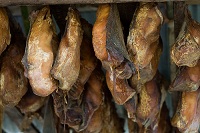 Origin: Iceland
Origin: Iceland
Description: Fermented Raw Shark Meat
This is the food that made the famous chef Gordon Ramsay spit it out on live TV. Hákarl begins its journey to your plate as a Greenland shark. In its natural state, the flesh of a Greenland shark contains a strong poison. The main toxin is trimethylamine oxide, which breaks down into trimethylamine, the chemical associated with the smell of rotting fish aroma, infected wounds, and human bad breath. Additionally, the meat contains high concentrations of urea. Getting hungry yet?
The shark meat can be made safe to eat, but probably nothing can be done to make it very tasty. Traditionally it is buried in gravelly beach sand and covered with heavy rocks. The rocks help discourage animals from digging up the rotting meat and press extra fluids out of the meat. After a two or three months of the beach sand treatment, a hákarl-loving person digs up the rotted meat, shakes off the sand, and hangs it in a special shed to dry and cure for another several months.
Once the hákarl expert determines that the meat is fully cured, the final preparation begins. The preparer cuts off the skin and other crusty stuff, slices the gelatinous meat substance into cubes, and proudly serves the finished hákarl to a willing (or unsuspecting) diner. Once diners accept the strong smell of ammonia and rotted fish, they convey the food treasure to their awaiting mouth with a toothpick or favorite eating utensil. If they don't vomit, they often return to the plate for another morsel until they have had their fill.
|
Casu Marzu
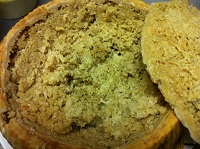 Origin: Sardinia , Italy
Origin: Sardinia , Italy
Description: Cheese Containing Live Maggots
Casu Marzu is a traditional Sardinian sheep milk cheese filled with live insect larvae. This cheese goes beyond fermentation to the verge of decomposition. Early in the fermenting process, the cheese maker introduces larva of the cheese fly, Piophila Casei. Within a few weeks, the larvae hatch and begin feeding. The larva's digestive process breaks down the cheese’s fats and produces a special distinct flavor many consider to be delicious. The cheese's texture is very soft, with some liquid seeping out.
Casu marzu can become toxic when the maggots in the cheese die, so people eat only cheese with live maggots. Many people meticulously remove the maggots before consumption. However, some leave them in to enjoy the added extra flavorful punch.
CAUTIONS:
- A bizarre fact about Casu Marzu is that the larvae in the cheese can launch themselves for distances up to 6 inches when disturbed. Those individuals who brave this dish are advised to hold their hands between the food (frequently in a sandwich) to prevent the maggots from leaping into their eyes.
- If you don't chew the maggots until they are dead, dire consequences can arise: the larvae (which are resistant to stomach acids) have powerful mouth hooks which can lacerate stomach linings or intestinal walls as the maggots attempt to bore through internal organs.
|
Balut
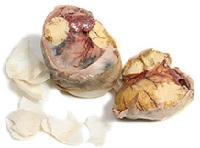
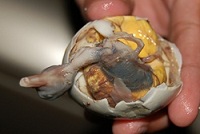 Origin: Philippines, Cambodia, and Vietnam
Origin: Philippines, Cambodia, and Vietnam
Description: Soft-Boiled Fertilized Duck Embryo
Balut is a fairly common street food available in Philippines, Cambodia, and Vietnam. It has also earned a widespread reputation as one of the all-time grossest ethnic delicacies. Most Americans are familiar with unfertilized eggs. Balut is made from fertilized duck eggs allowed to grow in the shell for a few weeks. They then are soft-boiled and served fresh and piping hot. Peel back the shell and you will find the small body of a fetal duck -- small bones, feathers, beak and all, some more developed than others.
Most people prefer to slurp it right from the shell after adding a pinch of salt. Many diners recommend you rinse your hands after you eat. Unless you are very skilled at eating balut, the egg juices can leave an unpleasant fishy smell on your hands.
|
Stink Head
 Origin: Alaska, USA
Origin: Alaska, USA
Description: Fermented Salmon Head
A traditional Alaskan delicacy is fermented salmon heads. The dish has earned the name “stink heads.” To create this culinary delight, bury the heads of King salmon in the ground in fermentation pits; put into plastic or wooden barrels, even plastic food storage bags; and let nature do its thing for a few weeks or more. Harvested the heads and consume as a putty-like mash.
Admittedly, salmon heads are not repulsive. Whole fish dishes are a legitimate part of cuisine everywhere and King salmon is a real delicacy world-wide. The “gross-out” factor is that much of the stink head prep process is less about fermentation and more about rot and decomposition. In reality, this dish is nothing but rotten salmon heads. Imagine, a bucket load of large King Salmon heads left outside during the warm summer months for a few weeks.
Outside the native Alaskan culture the stink head topic is nothing but a novelty, but health-wise the tradition of stink head consumption poses a real and continued challenge to regional Alaskan healthcare professionals faced with frequent and, sometimes serious, totally avoidable botulism cases.
|
Jellied Moose Nose
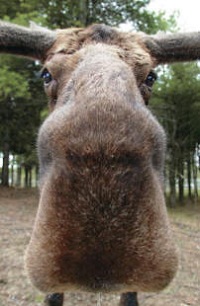
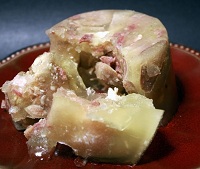 Origin: Northern USA
Origin: Northern USA
Description: Gelatinous Mass Made from Moose Nose Meat
The ‘jelly’ part makes it sound sweet, like a clear jelly you spread on a nice thick slice of toasted bread. But jellied is how the moose nose is prepared, not jelly as in bread spread. This is, after all the cooking is done, a traditional and time-honored Alaskan dish of real sliced moose snout.
Preparation is relatively simple: first, the moose‘s nose is removed. Then it’s boiled for a bit until the hairs become loose and can easily be plucked free. After a few spices are added, the meat is boiled even longer until it disintegrates into a gelatinous mass. Finally, it’s sliced and served chilled.
Enjoy...
|
Bat Paste Soup
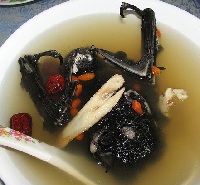 Origin: Thailand
Origin: Thailand
Description: Boiled and Mashed Bat in Spiced Broth
This delightful dish is considered weird even in the few Asian countries where it’s eaten. First, a live bat is forced into a vat of boiling milk. Then, once it has reached optimum malleability, the bat is sliced into fine bits, mixed with various herbs and spices, and mashed into a pulpy paste.
Bats are part of the native cuisine in Thailand, parts of China, Guam and more, but they are considered notorious disease carriers. You might want to consider dropping them to the bottom of your culinary To-Try list.
|
Hasma
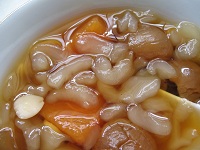 Origin: China
Origin: China
Description: Frog Fallopian Tubes
This disgusting dish is basically the fallopian tubes of frogs. It comes from a particular member of the frog family, not the common frog, though it is common in Jinlin and some northern regions of China. The frog is called the snow frog, also known as the Chinese forest frog, the white frog, and the winter frog.
Sold in a dried shrunken form, these amphibious reproductive organs are able to swell up to 10 to 15 times their dehydrated size once they are rehydrated with water. Afterward, a bit of sugar is added to give them that special sweetness most people desire from a dessert. In China, many people consider hasma dessert the perfect punctuation to a great meal.
|
Haggis
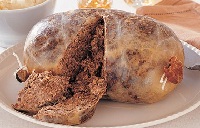 Origin: Scotland
Origin: Scotland
Description: Sausage of Sheep Lung, Liver, and Heart
A traditional Scottish dish, haggis is type of sausage comprised of a sheep’s lungs, liver, and heart. Some consider haggis the national dish of Scotland. Many describe haggis as resembling stuffed intestines more than sausage. However, although they admit it looks unappealing, Haggis-lovers swear that those who are brave enough to taste it will come running back for more.
In his poem, Address to a Haggis, Robert Burns shares a few of his thoughts describing his experience with Haggis: “gushing entrails bright ... stretch and strive ... olio that would sicken a sow, or fricassee would make her vomit ... perfect disgust ...." Also, an interesting scientific fact -- haggis contains too much fat and air for ultrasound to penetrate at diagnostic ranges.
|
Cockscomb
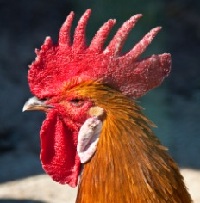
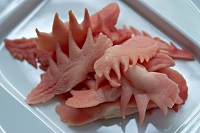 Origin: France
Origin: France
Description: Red Floppy Part from Rooster Head
The floppy red mass resembling an upside down glove on the top of a rooster’s head is known as a cockscomb (also called "le creste"). Once served as a garnish alongside many traditional French foods, cockscomb is still used as a common ingredient in many Italian dishes and sauces.
They have a slight taste of giblits, but are not overly offensive to those who don't know they are an ingredient in their food. Chef Pandel said, "They have an incredible texture, which most Western eaters find a bit troublesome, as it is gelatinous and soft. But if one is able to enjoy the texture, the flavor is unmatched."
|
Black Pudding
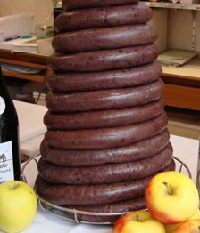
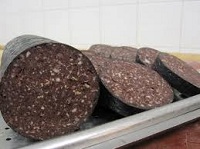 Origin: Asia, Europe, and Americas
Origin: Asia, Europe, and Americas
Description: Blood Pudding from Pig, Cattle, or Sheep Blood
Called blood pudding, blood sausage, or black pudding, this dish is comprised largely of blood drawn from pigs, cattle, or sheep. However, it doesn’t become blood pudding until the blood is allowed to coagulate, a filler of oatmeal, barley or sweet potato is added, and the entire mass is brought to a boil. During the cooking process, a delightful skin is produced atop the goo. While some like to remove the skin before plunging their spoon into the pudding, others enjoy its chewy texture and prefer to eat it last.
This type of sausage is made in many countries and goes by names like blutworst in Germany, boudin noir in France, and morcilla in Spain. It has been around for thousands of years, so it's obvious many people enjoy it for various reasons. Like many meat products, you can enjoy it if you don't know what's in it.
|
Surströmming
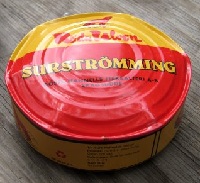
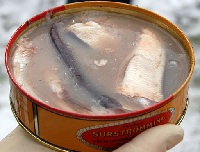 Origin: Sweden
Origin: Sweden
Description: Fermented Canned Herring
Surströmming is fermented canned fish which is so foul that it is mostly eaten outdoors due to the stench. The cans often bulge during shipping and storage, due to the continued fermentation. It has been banned by some airlines who say that it is an explosive safety hazard. Species of Haloanaerobium bacteria are responsible for the in-can ripening. These bacteria produce carbon dioxide and a number of compounds that account for the unique odor: pungent (propionic acid), rotten-egg (hydrogen sulfide), rancid-butter (butyric acid), and vinegary (acetic acid).
Usually people make an open sandwich with surströmming and a number of other ingredients. Boiled potatoes (often mandelpotatis or almond potatoes) are common, as are diced onion. Other common ingredients are gräddfil (fat fermented milk/sour cream) or crème fraîche, chives and sometimes tomato. Many people don't care for the smell and taste of surströmming (surprise, surprise), and it's generally considered to be very much an acquired taste.
|
Century Egg
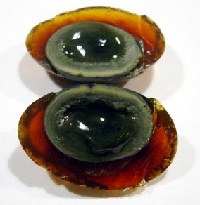 Origin: China
Origin: China
Description: Preserved Leather Egg - Duck, Chicken, or Quail
Century egg (called Pidan or alkalized egg ) is a Chinese cuisine ingredient made by preserving duck, chicken, or quail eggs in a mixture of clay, ash, salt, lime, and rice straw for several weeks to several months, depending on the method of processing. After the process is completed, the yolk becomes a dark green, cream-like substance with a strong odor of sulphur and ammonia (AKA farts or rotten egg), while the white becomes a dark brown, transparent jelly with little flavor or taste.
Raw eggs are soaked in a saline solution (15 days in summer or 20 days in winter), then buried in the soil mixture. It takes 30 days to cure chicken eggs and 45 days to cure duck eggs. Century eggs can be eaten without further preparation, on their own as a side dish or chopped and used as an ingredient. But whichever way you look at it -- you're still eating rotten egg.
|
Potted Meat Food Product
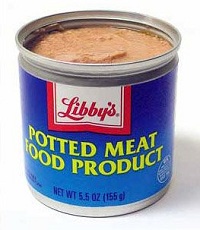 Origin: USA
Origin: USA
Description: Mystery Food Product Derived from Meat
Potted meat is not some strange foreign delicacy. In fact, this inexpensive meat product produced is available at most North American grocery stores. However, when it comes to grossness, this well-known product rivals anything you’ll find in a third world country. From the United States, here's an equal-opportunity offender to those who read food ingredients labels. Ingredients are: Mechanically Separated Chicken, Pork Skin, Partially Defatted Cooked Fatty Tissue, Partially Defatted Cooked Beef Fatty Tissue, Vinegar, Less than 2% of: Salt, Spices, Sugar, Flavorings, Sodium Erythorbate and Sodium Nitrite.
The folks at Armour have branded their version "America's #1 Choice." Hormel and Libby also offer their versions of this yummy treat. If you were wondering... Mechanically Separated Poultry
is a paste-like poultry product produced by forcing crushed bone and tissue through a sieve or similar device to separate bone from tissue. Mechanically separated poultry has been used in poultry products since 1969 after the National Academy of Sciences found it safe for use. In 1995 the final rule on mechanically separated poultry said it was safe to use without restrictions. However, it must be labeled as "mechanically separated chicken or turkey" in the ingredient statement. The final rule became effective November 1996.
|
|
|
|

 Origin: Iceland
Origin: Iceland
 Origin: Sardinia , Italy
Origin: Sardinia , Italy

 Origin: Philippines, Cambodia, and Vietnam
Origin: Philippines, Cambodia, and Vietnam
 Origin: Alaska, USA
Origin: Alaska, USA

 Origin: Northern USA
Origin: Northern USA
 Origin: Thailand
Origin: Thailand
 Origin: China
Origin: China
 Origin: Scotland
Origin: Scotland

 Origin: France
Origin: France

 Origin: Asia, Europe, and Americas
Origin: Asia, Europe, and Americas

 Origin: Sweden
Origin: Sweden
 Origin: China
Origin: China
 Origin: USA
Origin: USA